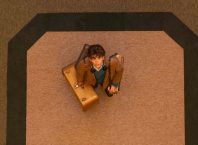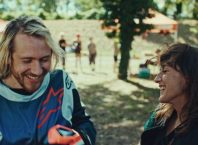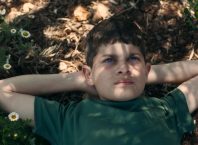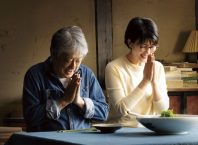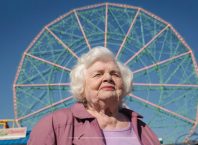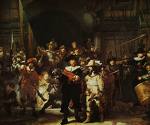
After getting to a rocky start with Thursday’s opening film, the festival rebounded today, and quickly settled into its regular hectic rhythm, where one’s sense of time is magically confused. As I write this article, the first screening I attended today feels like it happened at least a couple of days ago (and that’s only because I really enjoyed it- the second film I saw today feels even farther removed). So while every disappointing film will generally be rebutted by a pleasant surprise, only the particularly impressive ones stick in one’s mind. Today, that film happened to be that first film- Rembrandt J’Accuse, a documentary by Peter Greenaway.
It is not a great film and has the drawback of feeling like a History Channel special, as opposed to a particularly cinematic experience. Because of these reasons, I’m having a hard time explaining why I enjoyed it so inordinately.
The film is a counterpart to Greenaway’s Night Watch, from 2007, which was a fiction film about Rembrandt and the creation of his famous painting by the same name (and which is unseen by me). This film, made in 2008, is, to the best of my understanding, a documentary version of the story at the core of the fiction film. It is presented and narrated by Greenaway (often as a talking-head in a box somewhere on screen), and relates directly to his training as a painter. Greenaway is, with this documentary, trying to achieve two things. The first- he wants to convince the audience that hidden (or maybe not so hidden) within Rembrandt’s Night Watch painting are no fewer than 50 clues as to the circumstances and conspirators involved in the murder of a Dutch militia-leader, of which Greenaway presents and explains 30. His second goal is trying to discourage the notion that the written word reigns supreme, which results in most people not having a clue that a painting can be read, much less how one might do it.

The first sounds a little absurd, the second incredibly complex and ambitious. But somehow, I think he was successful –if only partially- in achieving both.
How did he convince me? The roots to that lie in the very opening of the film. We see a nicely lit shot of Amsterdam. The camera is moving, slowly and elegantly, while a racing police car is driving through the shot. However, in this one shot, different parts of the frame are accentuated. The frame has a night-time texture to it- dark, rich, blue. A small square of it, however, has a daylight texture- a very bright white. This square of daylight is following the police car across the screen for a little while, and then the police car leaves the daylight and goes into night, the whole color scheme is reversed, and different parts of the frame are accentuated in turn. I was too busy listening to Greenaway’s narration and the driving music to really understand what I was seeing- but after leaving the film, I realized that the audience was being prepared for the idea of examining an image in different ways, picking up on patterns, zeroing in on particular section, and figuring out how they fit in the grand scheme of things. An opening that at first seemed like it was simply an entertaining way to start the film off with a rush, in retrospect was priming its audience. This is Greenaway’s method for achieving his goals- he is not being cryptic or enigmatic, nor is he being polemic. He is presenting something that is engaging and entertaining when taken at face value, and explaining his theories by simply showing exactly they work.
That is more about his second issue- he’s illustrating at how much more there can be to an image than people expect. As for his first issue- he presents this as simply and straight-forwardly as possible. According to the narration, the police car from the opening sequence is rushing to the scene of a crime. What crime? Murder most foul. Who? When? Where? Why? How? The answers to all these questions, and many more, can be found with Rembrandt’s famous painting (alleged by Greenaway to be the 4th most famous painting in the world). Greenaway does occasionally revert to a mock Law & Order type structure, where he, as a prosecutor, is asking characters from Rembrandt’s life about the case (portrayed by the actors he used in the fiction film).
His main method is presenting each different clue, one by one, numbered in a big 1-30, and through some very clever and inventive use of computer graphics, point out exactly how where this clue appears in the picture. Some of the clues are easier to swallow than others- some are blazingly clear once he presents them, others seem like he might be reaching. By the end of it, one is so overwhelmed by the amount of things going on in this one painting, that I was firmly convinced that A- Greenaway’s murder-conspiracy theory can theoretically be correct (I have to take his word for it) and B- There’s a lot more to be seen here than meets the eye. He didn’t knock the ball out of the park on either count…but he came a whole lot closer than I would have thought possible.
I really had fun with this film- I was exhilarated by the creativity in the presentation of what is essentially following the template of a particularly good History channel special. It is extremely relatable, and I would think it would be fascinating to anyone whose knowledge of painting is extremely limited (As is my own). Greenaway does go off on a couple of tangents that aren’t as convincing as the rest of the film (an early one decrying the visual illiteracy of filmmakers sounds more spiteful than anything, even if he’s not wrong), but he is extremely passionate- so passionate that he tried to make this film more accessible and relatable than probably any other film he’s made (Apparently, the film is available as a special bonus feature on the Night Watch DVD).
Rembrandt’s J’Accuse
Peter Greenaway Netherlands/UK 2008
Screenings: 14.7 at 13:15, 17.7 at 15:15, 18.7 at 10:15
www.jff.org.il
Jerusalem Cinematheque, 11 Hebron Road, 02-565-4333
SHLOMO PORATH

